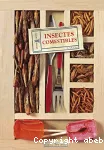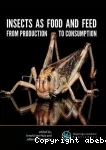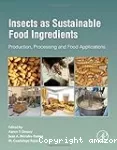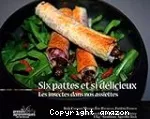Adresse
Infodoc : Réseau des bibliothèques et centres de documentation d'AgroParisTechFrance
contact

Catégories
|
RAMEAU , Nom commun , Entomophagie
Entomophagie
Commentaire :
Consommation d'insectes par les ªtres humains
Synonyme(s)Insectes -- Alimentation humaineVoir aussi : |
Documents disponibles dans cette catégorie (16)
 Ajouter le résultat dans votre panier
Visionner les documents numériques
Faire une suggestion Affiner la recherche Interroger des sources externes
Ajouter le résultat dans votre panier
Visionner les documents numériques
Faire une suggestion Affiner la recherche Interroger des sources externes
 Livre
Livre978-3-030-32951-81 vol. (314 p.)
1 vol. (314 p.)ISBN : 978-3-030-32951-8 
 Livre
Livre
 Livre83 F
Livre83 F978-2-88353-013-01 vol. (156 p.)
1 vol. (156 p.)Prix : 83 F ISBN : 978-2-88353-013-0 
 Livre
Livre978-3-030-22521-61 vol. (XIV-120 p.)
1 vol. (XIV-120 p.)ISBN : 978-3-030-22521-6 
 Thèse
Thèse
 Livre19,90 EUR
Livre19,90 EUR978-2-915810-81-31 vol. (152 p.)
1 vol. (152 p.)Prix : 19,90 EUR ISBN : 978-2-915810-81-3 
 Livre16 EUR
Livre16 EUR978-2-7592-2454-81 vol. (183 p.)
1 vol. (183 p.)Prix : 16 EUR ISBN : 978-2-7592-2454-8 
 Livre15 EUR
Livre15 EUR978-2-8126-0510-91 vol. (125 p.)
1 vol. (125 p.)Prix : 15 EUR ISBN : 978-2-8126-0510-9 
 Livre6,80 EUR
Livre6,80 EUR978-2-330-13514-01 vol. (149 p.)
1 vol. (149 p.)Prix : 6,80 EUR ISBN : 978-2-330-13514-0 
 Livre
Livre
 Livre
Livre978-90-8686-296-21 vol. (447 p.)
1 vol. (447 p.)ISBN : 978-90-8686-296-2 
 Livre
Livre978-0-12-802856-81 vol. (XV-385 p.)
1 vol. (XV-385 p.)ISBN : 978-0-12-802856-8 
 Livre2 321 EUR
Livre2 321 EUR978-2-8190-7156-31 vol. (207 p.)
1 vol. (207 p.)Prix : 2 321 EUR ISBN : 978-2-8190-7156-3 
 Bulletin
Bulletin
 Livre24 EUR
Livre24 EUR978-2-7535-5142-81 vol. (434 p.-[32] p. de pl.)
1 vol. (434 p.-[32] p. de pl.)Prix : 24 EUR ISBN : 978-2-7535-5142-8 
 Livre
Livre978-2-87016-130-21 vol. (72 p.)
1 vol. (72 p.)ISBN : 978-2-87016-130-2






